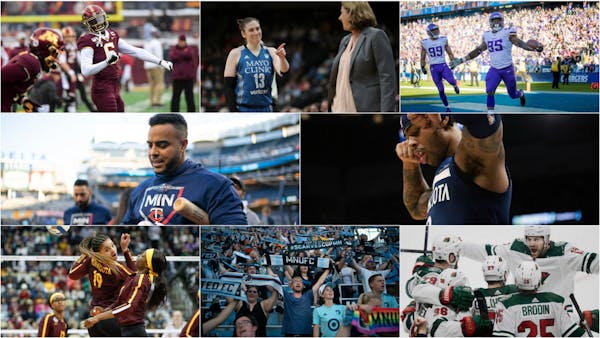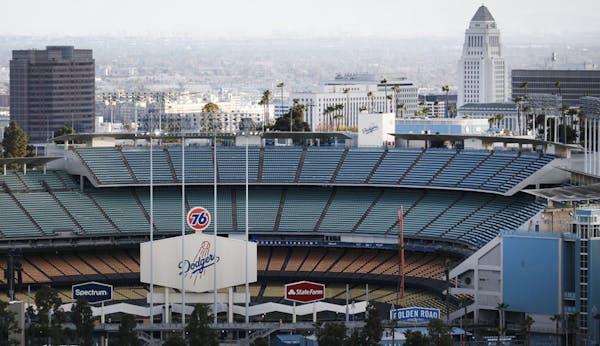As the Twins try to zero in on whom they might acquire in next month's amateur draft, it's hard not to think about what they'll miss out on, too.
"I'm a little sad that we won't get a Taylor Rogers. We won't get a Brian Dozier. No Mitch Garver," said Deron Johnson, the former Twins scouting director who is now a senior advisor to current scouting director Sean Johnson. "There are some good big leaguers in the draft beyond the fifth round, and it's really exciting to watch them reach that potential. I feel sad for guys like that, who won't get drafted."
Major League Baseball, in an effort to slash costs during the coronavirus pandemic, informed its 30 teams last week that the annual June draft, which once had an unlimited number of rounds but has lasted 40 rounds since 2012, will be limited to only five rounds when it begins on June 10, cutting the numbers of drafted players from more than 1,200 (there were 1,217 last summer) to 161.
And only four of them will become potential Twins. The defending AL Central champions own the 27th overall pick in the first round, due to their 101-win finish in 2019, and the 59th pick in the second round. The Twins will also choose 128th and 158th in the fourth and fifth rounds. A competitive-balance pick after the second round, No. 66 overall, was sent to the Dodgers in February as part of the trade for Kenta Maeda, and the team forfeited its third pick, which would have been 99th, by signing Josh Donaldson as a free agent in January.
“We're not thrilled about the design of that part of it this year. It's not a level playing field. But every team will have different ways of trying to sweeten the deal within the rules. ”
The Twins will be limited to spending $4.53 million on those four picks, divvied up any way they negotiate, with their first-rounder slotted for $2.57 million and their second-rounder $1.18 million. In another cost-saving move, draftees will receive 10% of their bonuses this year, and 45% each of the next two Junes.
"It's not many players, but in the upper tier of the draft, we feel it's an above-average group this year. We're still excited about the talent we'll be able to add," said Sean Johnson, who makes the final call for the Twins. He expects the draft to be unusually heavy on college players, with few high school players taken after the first round or two, "because teams will understandably feel safer taking players they have followed for two or three years," he said.
Sizing up the talent
Sean Johnson compared this year's pool of prospects to that of 2018, when the Twins took Oregon State outfielder Trevor Larnach in the first round and North Carolina-Wilmington catcher Ryan Jeffers in the second — a pair of players who could reach Target Field this year or next. "We took those guys in similar [draft] spots. We're hoping for similar type players with both picks," he said. He pointed out that Larnach probably wasn't a first-round player when 2018 began, but worked his way into it with a strong, College World Series-winning season.
"The guys who would have climbed that ladder this year, we'll just never know. It's tough for them, but we feel like there are five pretty solid rounds of guys" available, he said. "Once you get past the fifth round, the lists for all teams get kind of flat — there's not much separation between players. But we know there are a lot of players in that group who we'd love to have, and we'll pursue them. We'll want them to be Twins."
Just like the Twins' two veteran scouts wanted lesser-known prospects such as Rogers (an 11th-round draft pick in 2012), Dozier (eighth round in 2009), and Garver (ninth round in 2013) in previous years. But with the truncated draft, a new wrinkle has been adopted this year: All eligible but undrafted players are free to sign with any team — but for a maximum bonus of just $20,000, a pittance compared to the six-figure bonuses that routinely are handed out to players in the first eight to 10 rounds in most years.
"Right now there are 500 players who think they'll go in the top five rounds, and they just won't all fit in there. There will be a lot of players who will have aspirations of going in the fourth or fifth round and then they don't," Sean Johnson said. "Depending on their college situation, a lot of factors, those players may not take $20,000. They'll go back to school and try to do better next year."
Johnson expects many, and probably most, players who just miss being drafted to take that route, now that the NCAA has granted spring-sport seniors an extra year of eligibility after the 2020 season was canceled. But some might be wary of crowded college rosters, of losing scholarships or playing time, or of delaying their professional development by a year.
Those players will listen to sales pitches from MLB teams, none of whom, because of the spending limit, have the ability to outbid each other.
"It's going to be like college recruiting," Deron Johnson said. "You've got to sell your program."
'Not a level playing field'
That might be a big advantage to big-market teams with the largest payrolls, since players might calculate they can make more money if and when they reach the majors. And some might choose organizations close to their homes, an advantage for Texas, California and Florida teams that the Twins cannot match.
"We're not thrilled about the design of that part of it this year. It's not a level playing field," Sean Johnson said. "But every team will have different ways of trying to sweeten the deal within the rules. We have plans for that, but really, nobody knows because we've never had this level of talent in that pool."
The Twins feel relatively well-positioned for the post-draft scramble, partly because the organization has made the playoffs in two of the past three seasons and appears to be on the way up. It also has a minor league academy in Fort Myers, Fla., complete with a year-round players dorm, that few teams can match.
And their scouting staff includes several former college coaches and assistant coaches. "We feel like we know what means something to those players and what doesn't. We've kind of put together a game plan for that," Sean Johnson said. "I'm sure there will be some surprises, but we'll see what happens."
It will be the first virtual draft in MLB history, so the Twins have contacted 10 NFL teams, including the Vikings, to learn what worked and what didn't during last month's NFL draft-from-home. "We're doing a ton of work behind the scenes to get ready for that part of it, too, since we won't be in the same room," Sean Johnson said.
Mostly, though, the Twins scouting director is focused on those four draft picks and determining which prospects are best — not easy since no college, junior college or high school has played a game in two months. Scouts are poring over videotape of top prospects and doing far more interviews than usual. With no games to play, potential draftees, usually mostly off limits during their seasons, are available for video chats and phone calls.
"Our staff has done an incredible job of finding ways to learn about players. We've talked to several college coaches, we've talked to strength coaches, we've talked to summer ball coaches, we've talked to trainers," Sean Johnson said. "We just want to make those four picks count."
Body of missing teenage boy recovered from southwest Minnesota lake

High winds flipped a FedEx truck traveling on Bong Bridge in Duluth

A tale of 124 hoarded Minnesota cats has at least a hundred happy endings


